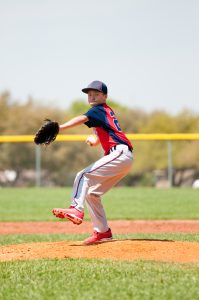Overuse Injury In The Child Athlete
 Overuse injury is a significant risk among children and teenage athletes. Repetitive training and performance can place excessive stress on the developing bones, joints, ligaments and musculature. Further, the child athlete, coaches and parents may not recognized the signs of an overuse injury. Sadly, it is estimated that 50% of the overuse injury in the child athlete can be prevented!
Overuse injury is a significant risk among children and teenage athletes. Repetitive training and performance can place excessive stress on the developing bones, joints, ligaments and musculature. Further, the child athlete, coaches and parents may not recognized the signs of an overuse injury. Sadly, it is estimated that 50% of the overuse injury in the child athlete can be prevented!
Types Of Injuries
There are two broad categories of injuries that kids will suffer: acute and overuse. An acute injury usually happens with one single instance, a traumatic event such as a fall, a collision or a sudden twisting motion.
Overuse injury is more difficult to diagnose and treat. Overuse injuries are more subtle and develop slowly over time. When joints, tendons or muscles are subjected to repetitive low forces on a repeated basis, overuse injury occur. Common overuse injuries include tennis elbow, swimmers shoulder and stress fractures.
Factors Causing Overuse Injuries
There are many factors that can contribute to overuse injuries, some include improper technique, poor or ill-fitting equipment, and improper or over training. Sometimes there are certain anatomic issues that can cause and athlete to be predisposed to overuse injury: one leg shorter than the other, pelvic rotation or genu varum (bowlegged) or genu valgum (knocked knees).
Signs Your Child May Have an Overuse Injury
In most instances, a child will tell you when they are hurt. However, due to a competitive nature or social pressure from peers, parents or coaches, some will try to tough it out. There are signs of injury that you should be aware of, such as:
• Favoring one side of the body (ie limping), failing to fully use an arm or leg or completely avoiding the use.
• Obviously, appearing to be in pain when performing a specific motion or using a body part
• Unable to sleep at night or restlessness, tossing or turning. Unable to get comfortable
• Pain has a gradual onset
• Pain initially presents as an ache vs sharp or stabbing
• There is no history of direct injury to cause the pain
• Aching or stiffness, especially around joints, during or after training or competition
• Increasing recovery time from painful episodes
• Visible swelling, especially around joints
• Pin-point tenderness, especially near joints
• Recurring symptoms, especially after periods of rest
Do not confuse these signs with “growing pains” and they should be taken seriously.
Additionally, pain in the arm or easy fatigue, decreased throwing performance should be recognized as the early warning signs of a possible overuse injury in throwing athletes.
Sharp stabbing pain is an indication your child should stop play right away. The idea of “playing through” this pain can shorten your child’s season by making an injury worse.
What You Can Do For An Overuse Injury
1. Stop participation or at least the specific motion.
2. Initially, ice the area (Instructions)
3. Use heat approximately 3 days after the initial onset of pain/inflammation or swelling (instructions)
4. Child should be pain free in activity before returning to play
5. Seek qualified treatment form a healthcare provider trained in sports injury. Unfortunately, most pediatricians or PCP have limited training in this area. The typical treatment they recommend is rest, ice or heat and anti-inflammatory medication.
Proper treatment of overuse injury MUST go beyond the initial pain period and address the bio-mechanical causes of the overuse.
If you think your child is suffering from an overuse injury, call our office today at (314) 731-4383 or CLICK TO CALL NOW! As a 1984 graduate of Life Chiropractic College, Dr. Martin Schmaltz has years of helping those who are experiencing pain, especially those in the extremities. He is board qualified in sports injury through Los Angeles Chiropractic College and has extensive training in treating extremity and sports injury.
